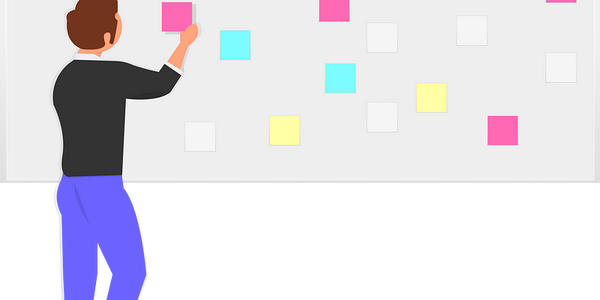
“Design thinking is a human-centered approach to innovation that draws from the designer’s toolkit to integrate the needs of people, the possibilities of technology, and the requirements for business success.” (Tim Brown)
TL;DR
- Design thinking is a proven, repeatable and reliable problem-solving process.
- Design thinking is a problem-solving tool that can be applied to problems of any size, in any industry and for practically any product, service or process.
Introduction
Thinking like a designer is nothing new. However, it has become considerably more fashionable over the last couple of years. Nowadays the term design thinking is omnipresent. In today’s fast-paced world companies are struggling more than ever to come up with new ideas, products and services to satisfy instant gratification. Coupled with an even more crowded market and increased competition, companies are constantly challenged with the need to stay relevant and attractive in order to retain customers. Product and service design is a complicated process and resources are limited. Companies understand the importance of finding new ways and resources to build, develop and produce future products.

There is an imminent need for new processes and techniques of working to identify the client’s needs and to provide appropriate solutions. Design thinking is a proven process to design user-centric products, which can support your company to remain a sustainable and profitable.
In this article, we explore the crucial factors of design thinking and suggest several new ways how it could be applied.
- We critically review design thinking from an academic and professional point of view.
- We prove that design thinking is a time-proven method to solve complex problems.
- We provide precise examples of the limitations associated with design thinking.
- We show why ethical issues need to be considered when it comes to data-driven products and human-centric design.
Design thinking is an innovative problem-solving process to tackle the unknown. It’s a means of going on an expedition, without a map, without even knowing the destination, but with the confidence that you’ll end up somewhere great. Whatever the challenge, design thinking is a powerful tool to reveal new ways of thinking and doing. (Daylight, 2013)
The origin of design thinking

Nowadays it is assumed that design thinking is a silver bullet for solving humanity’s problems. It is viewed as a modern, cutting-edge tool to help companies achieve all of their unreachable goals. However, design thinking is neither a silver bullet nor some new, fancy way of operating. The methodology of design thinking has been around for decades. Herbert Simon published the sciences of the artificial already in 1969. A body of work that has given new insights into the classification of design. In his more work, Simon (2008) stated that everything designed should be seen as artificial. In 1972 Horst Rittle and Melvin Webber coined the term Wicked Problems. They were one of the first authors to emphasise the importance of human perception and experience within the design process (Rittel and Webber, 1973).
Five years later, research in the field of human-computer-interaction started investigating the use of design methodology. His work focused on the way designers think and how their decision process differs from other professions (Cross, 2010).
Combining the theories of Rittel et al. (1973) and Simon (1969,2008) and the hands-on practice of Ezio Manzini, Richard Buchanan reintroduced the discussion of wicked problems and the role of design solving them. His pioneering research made an important link between innovation and design thinking.
In 1991 IDEO forms out of a three-way merger. With building multidisciplinary teams supported by experts out of business strategy, anthropology, health care or education, they became an awarding winning agency quickly with global recognition. IDEO’s CEO Tim Brown is an advocate for design thinking and his book Change by Design (2009) became a definitive book for design thinking enthusiast around the world.
By 2003 selected universities across Europe and the USA started teaching service design to its students. The new methodologies which were focusing on complex problem solving also created a new wave of design tools. New processes, like co-creation or participatory design, emerged. The shift towards multidisciplinary teams and collaborative design has opened internalised creative processes and new mindsets to build more transparent and usable solutions for everyone.
Models of design thinking

There is a wide variety of different models explaining how design thinking can be used to solve complex problems. In this article, we are focusing on three well-known models:
Design council’s “Double Diamond”
The double-diamond model covers four phases. First, the discover phase helps to gather insight into the problem. Second, the define phase helps to make sense of all the possibilities identified in the discovery phase. The outcome should be a clear brief that frames the fundamental design challenge. Third, the develop phase is the breeding ground for new concepts. Here, solutions are drafted, prototyped, tested and iterated. Through the process of trial and error, ideas are improved and refined. Finally, in the deliver phase, the solutions are finalized, and the product or service is launched. The double diamond shape tries to visualize how the team loses and gains focus again during the process (figure 1). The problem, its definition and the final solution should not leave room for interpretation (Design Council, 2017).
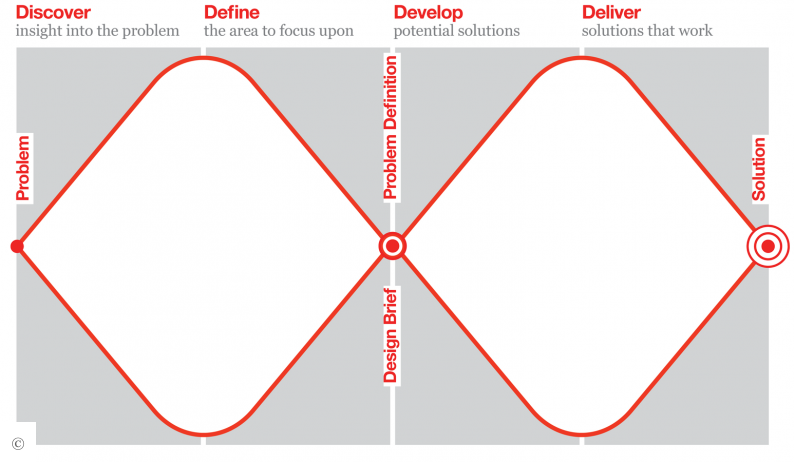
Our team is working with a refined version of the double-diamond model (figure 2). The main differences are a more definite separation of each phase and its purpose and an appreciation that it is a non-linear process. We combine the double-diamond model with the Google Design Sprint Kit. The Google design sprint framework was created in 2010. Over the years, working alongside Google Ventures, Google studied and tested 300 different business strategies, design thinking, and user research methods. Google took the most effective strategies and evolved them, arranging them into a framework that supports both divergent thinking and convergent thinking. The methodology has developed over time and continues to be refined and tested. (Knapp, Zeratsky and Kowitz, 2016)
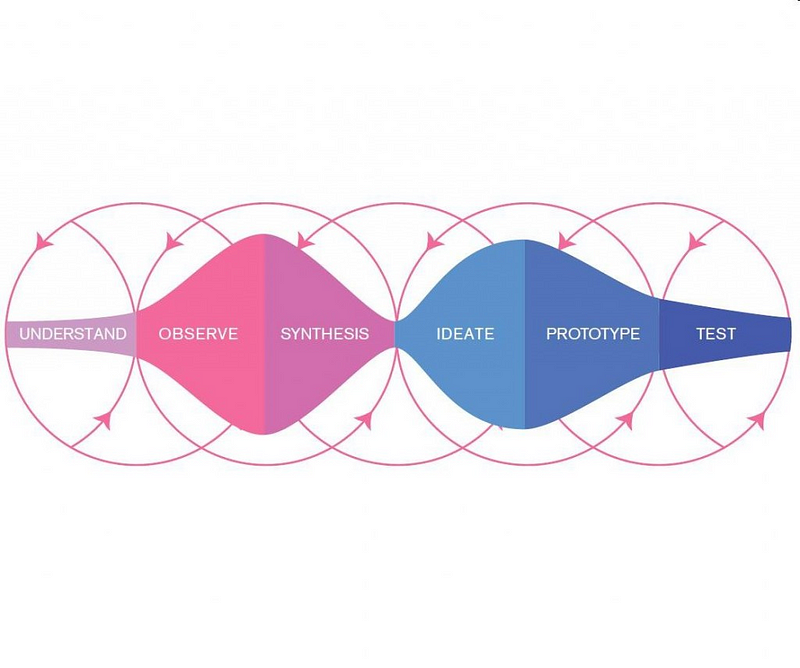
d.school
The famous model of Stanford University’s Institute of Design follows a very similar approach as the double diamond model (figure 3). The d.school model acknowledges that empathy is the centerpiece of a human-centered design process. During the empathize stage of the model, the focus is on understanding people, within the context of the design challenge. The define stage is all about bringing focus and clarity to the design space. The ideate phase provides the source material for building prototypes and getting innovative solutions into the hands of the users. The prototype phase allows for an iterative generation of artefacts helping to answer questions to get closer to the final solution. Finally, in the test phase, user feedback is gathered. Another chance to understand your users better.
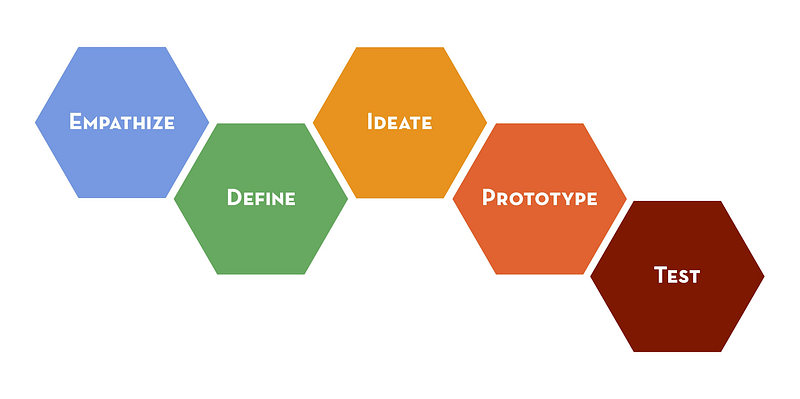
IDEO’s innovation and design process
IDEO’s human-centered design model consists of three phases (figure 4). The inspiration phase is the first step to build empathy with the people you are designing for. It is an immersive experience to understand the needs of your target audience better. The ideation phase helps to make sense of all the gathered information and the things you learned. New opportunities are identified, and prototypes of possible solutions are built. Finally, during the implementation phase, the solutions are brought to life and might be implemented in a real-world scenario. (The field guide to human-centered design, 2015)
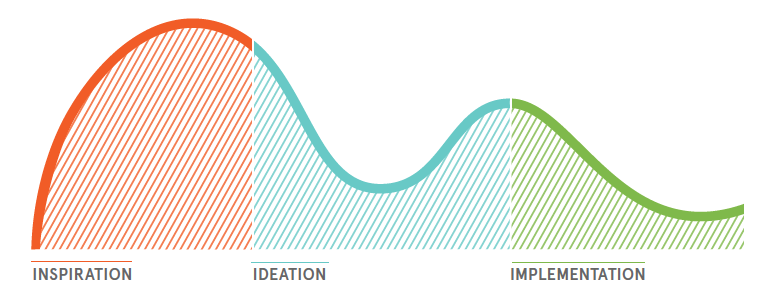
A critical approach to design thinking
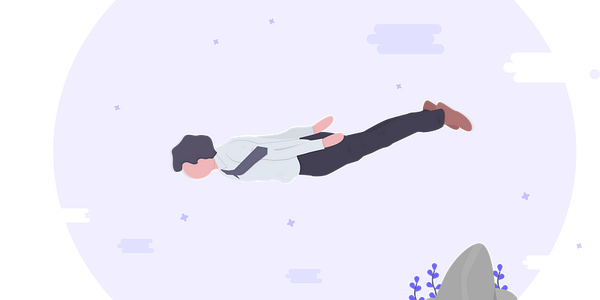
Design thinking by itself will not save the business world. The concept lacks in topics of team dynamics and change management, especially from the view of academic research. We have to understand what prevent teams from reaching innovative solutions and what stops them from solving complex problems. Many underlying factors can have an impact on the design thinking process, such as egos, mindsets, language, skills, team constructions, culture, time, money etc. It is essential to be aware how small and seemingly unimportant obstacles can affect a team’s progress. People tend to want to be spontaneous in their reactions when facing a challenging situation. It is easier to pinpoint the obvious factors rather than analyzing more subtle but perhaps more influential issues. This is known as attacking symptoms of the problem instead of understanding it as a whole. Truly innovative and impactful solutions require an empathic and holistic understanding of the problem. Teams need to resist the urge to react impulsively. Design thinking is very ideation-based. Coming up with new ideas without the burden of understanding constraints will not necessarily solving wicked problems (Malbon, 2016).
Also, people tend to agree with group decisions. This can be for reasons of peer pressure, self-confidence issues or fear of being rejected. The result can be groupthink. This is a phenomenon that occurs within a group of people in which the desire for harmony or conformity in the group results in an irrational or dysfunctional decision-making outcome. (Turner and Pratkanis, 1998) In design thinking ideas and decisions must be based on user insights and user testing. Groupthink might result in a less critical approach when trying to solve a problem. To avoid this scenario, team managers need to create a safe and playful space for individuals to express themselves, throw ideas out there, and not feel targeted (Dam and Siang, 2017).
Furthermore: “To the man with a hammer, every problem looks like a nail.” (Charlie Munger) For reducing the cognitive load, the human brain works in following familiar patterns. This can result in solving problems, which appear similar to previously solved ones, with the same set of methods. Working with design thinking it is essential to form cross-disciplinary teams to avoid this issue.
Developing a holistic understanding of the problems and needs of our target users remains one of the vital elements of design thinking.
Ethics

Design ethics is a complex but highly relevant topic. The ethical concept spans all areas from spanning several categories from professional responsibility to confidentiality and behavior to conflicts of interest. The difficulties arise from the variety of explicitly right or wrong answers that exist when it comes to ethics. In fact, if one were to ask five different people about design ethics, you would probably obtain five different answers. The concept can be culled down into two basic ideas:
- Design ethics establish behaviors and actions which are accepted in the profession.
- Design ethics help to raise the standard of work and representation.
Putting these ideas together results in the following definition: Design ethics helps to raise the standard for work by establishing behaviors and actions that are acceptable in the professional community and for clients (Cousins, 2017).
Design professionals have certain basic obligations to society, to clients, to the profession, and to peers and colleagues. Ethical Standards are more specific goals to which design professionals should aspire in professional performance and behaviour. (Designproacademy.org, 2017).
Ethical work to its customers has become more and more important. Furthermore, for providing new data-driven and personalised products, ethical standards need to become core values and need to underline the design thinking process. Not acknowledging that ethical design is essential could result in the imminent loss of trust from our readers.
Furthermore, ethics have a direct impact when it comes to design thinking. Working user-centric implies having close interactions with real people. Having their trust is not self-evident, and this comes with great responsibility. We have to ask ourselves how we are gaining and sharing insights about people in an ethical way. A good starting point is The Little Book of Design Research Ethics by IDEO. Responsibility, honesty and respect are forming the core principles helping to ensure that interactions are safe, fair, enjoyable, and mutually beneficial (Kelley and Suri, 2015).
Facts
- Design-driven companies have outperformed the S&P Index by 219% over ten years (Harmer, 2015)
- Design-led firms consciously put the customer first, with 46% of design leaders citing an emotional bond with customers as a defining characteristic of an advanced design practice. (Abramovich, 2017)
- 71% of respondents on a large-sample survey of design thinking report that design thinking improved their working culture on a team level (Schmiedgen, 2015)
- 69% of respondents on a large-sample study of design thinking perceive the innovation process to be more efficient with design thinking (Schmiedgen, 2015)
- 50% of design-led companies report more loyal customers as a benefit to having advanced design practices. (Murray Brozek, 2016)
Conclusion

Design thinking is a proven, repeatable and reliable problem-solving process any business or profession can use to achieve great results. The critical element is thinking and ideating a solution to solve a problem or a need. Companies often miss investing the time to understand the problem truly, to iterate the solution and then to measure the result. Design thinking should be at the core of strategy development and organisational change to create a culture that is focused on this way of solving problems. This form of thinking can be applied to products, services, and processes; anything that needs to be improved (Forbes.com, 2017).
Design thinking can be implemented in any company. We are aware that becoming a design-centric company will take considerably longer than it would for a young startup. But, design thinking is a user-centric approach, and most teams already have the client at heart. Processes are not ideal and generated ideas still serve the different groups more than they serve our customers. Decisions are made in isolation without the full context which can fail once rolled out to the customers.
Design thinking is about applying design strategies to different teams and functions. It helps to minimise the uncertainty and risk of new ideas by letting the customer challenge them.
References
- Abramovich, G. (2017). Design-Led Businesses Do These Three Things Right. [online] Cmo.com. Available at: http://cmo.cm/2hRTdLV [Accessed 2 Nov. 2017].
- Bellet, Paul S. and Michael J. Maloney (1991). The importance of empathy as an interviewing skill in medicine. JAMA.
- Cousins, C. (2017). What Are Design Ethics? (And Why Are They Important?) | Design Shack. [online] Designshack.net. Available at: http://bit.ly/2jp3pMh [Accessed 7 Nov. 2017].
- Cross, N. (2010). Designerly ways of knowing. Springer London Ltd.
- Daylight (2013). What is Design Thinking. [video] Available at: http://bit.ly/2zEiVtO [Accessed 21 Nov. 2017].
- Design Council. (2017). The Design Process: What is the Double Diamond?. [online] Available at: http://bit.ly/2fSMSPs [Accessed 5 Oct. 2017].
- DesignBetter.Co. (2017). Design Thinking Handbook. [online] Available at: http://bit.ly/2zYAHWB [Accessed 12 Oct. 2017].
- Designproacademy.org. (2017). The Academy of Design Professionals — Code of Professional Conduct. [online] Available at: http://bit.ly/2jdhGrE [Accessed 6 Nov. 2017].
- Forbes.com. (2017). Why Design Thinking Should Be At The Core Of Your Business Strategy Development. [online] Available at: http://bit.ly/2A1QKmO [Accessed 12 Oct. 2017].
- Harmer, T. (2015). 4 key stats on the importance of design for business | Creative blog by Adobe. [online] Creative Connection. Available at: https://adobe.ly/2iDL2jz [Accessed 2 Nov. 2017].
- Kelley, D. and Suri, J. (2015). The little book of design research ethics. IDEO.
- Knapp, J., Zeratsky, J. and Kowitz, B. (2016). Sprint. Bantam Press.
- Malbon, T. (2016). The Problem with Design Thinking — Made by Many — Medium. [online] Medium. Available at: http://bit.ly/2hHepAm [Accessed 7 Nov. 2017].
- Murray Brozek, C. (2016). Design-led firms win the business advantage.. [online] Landing.adobe.com. Available at: https://adobe.ly/2zViyLN [Accessed 2 Nov. 2017].
- Obstacles to Problem Solving and Innovation in Design Thinking. [online] The Interaction Design Foundation. Available at: http://bit.ly/2moVteX [Accessed 7 Nov. 2017].
- Rittel, H. and Webber, M. (1973). Dilemmas in a general theory of planning. Berkeley, Univ. of California, I.U.R.D.
- Schmiedgen, J. (2015). Parts without a whole?. Potsdam: Univ.-Verl, p.100.
- Schmiedgen, J. (2015). Parts without a whole?. Potsdam: Univ.-Verl, p.103.
- Simon, H. (2008). The sciences of the artificial. Cambridge, Mass. [u.a.]: MIT Press.
- The field guide to human-centered design. (2015). [San Francisco]: IDEO, p.13.
- Turner, M. and Pratkanis, A. (1998). Twenty-Five Years of Groupthink Theory and Research: Lessons from the Evaluation of a Theory. Organizational Behavior and Human Decision Processes, 73(2–3), pp.105–115.